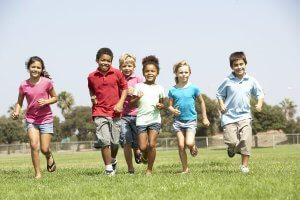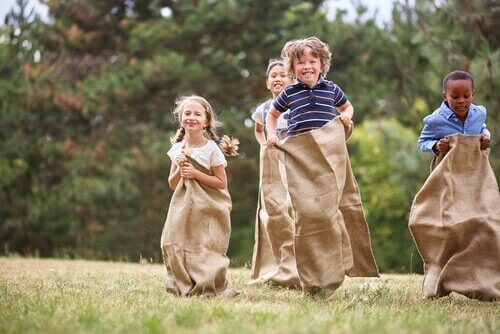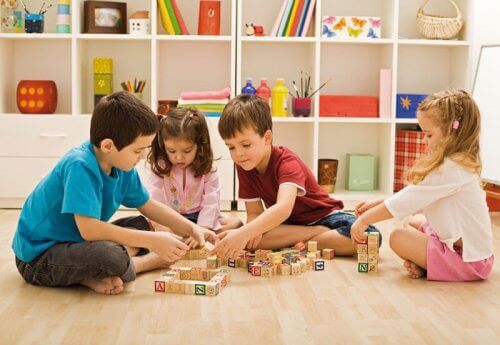4 Recess Games for Kids

Recess games for kids are activities that involve one or more participants. Their main function is to provide players with fun and entertainment. These games also help children build focus and stimulate their social, emotional, and physical development.
Participating in recess games promotes and develops children’s knowledge, so we recommend doing this type of activity outside so that children can enjoy them in a healthy, social way.
4 recess games for kids
Below we’ll offer a few examples of recess games for kids:
1. The handkerchief game
The first option is the traditional handkerchief game. The rules are simple. All you need is a large group of kids and a handkerchief.
To start, divide the players into two teams. Each team goes to one end of the field. Draw an imaginary line down the middle of the field. Each team then assigns a number to each of their players.
The referee stands between the two teams holding the handkerchief. The referee shouts a number to indicate who should come to try and get the handkerchief. The player who gets there first wins, and the other is disqualified.

2. Sack races
Sack races are a perfect activity for kids to do outside, especially in the country. This is a competitive game that develops strength and agility.
To begin, the participants get inside potato sacks, trash bags, or pillow cases. The children have to follow a marked path. Depending on their age, you can adjust the distance and difficulty of the course.
—Loris Malaguzzi—
3. Hot potato
This game is about observation and reflexes. To play, the kids sit on the floor in a circle. The teacher puts on some music.
During the game, the children pass the ball around the circle as fast as possible, as long as the music is playing.
If you don’t have music, a child can sit in the middle of the circle and count. When the music stops, the player holding the ball is out.
The game continues until only one child is left. This child is the winner. To make the game more fun, you can add variations like passing the ball to whoever the teacher names.
Without a doubt, the objective is to improve speed and reaction times. It also works on cognitive development and cooperation.

4. The never-ending story
The last game is an ideal way to stimulate the imagination: the never-ending story. This is an oral game ideal for entertaining the minds of children.
To play, one of the participants starts telling a story. The next player adds a sentence, but always starting again from the beginning and repeating what others have said. The game consists of repeating all the sentences one after another until one of the players makes a mistake.
In closing, remember that recess games for kids are fun activities that promote their physical, social, and mental development, as well as aspects of their personality.
The previous examples are perfect ways to entertain kids and stimulate their development.
Recess games for kids are activities that involve one or more participants. Their main function is to provide players with fun and entertainment. These games also help children build focus and stimulate their social, emotional, and physical development.
Participating in recess games promotes and develops children’s knowledge, so we recommend doing this type of activity outside so that children can enjoy them in a healthy, social way.
4 recess games for kids
Below we’ll offer a few examples of recess games for kids:
1. The handkerchief game
The first option is the traditional handkerchief game. The rules are simple. All you need is a large group of kids and a handkerchief.
To start, divide the players into two teams. Each team goes to one end of the field. Draw an imaginary line down the middle of the field. Each team then assigns a number to each of their players.
The referee stands between the two teams holding the handkerchief. The referee shouts a number to indicate who should come to try and get the handkerchief. The player who gets there first wins, and the other is disqualified.

2. Sack races
Sack races are a perfect activity for kids to do outside, especially in the country. This is a competitive game that develops strength and agility.
To begin, the participants get inside potato sacks, trash bags, or pillow cases. The children have to follow a marked path. Depending on their age, you can adjust the distance and difficulty of the course.
—Loris Malaguzzi—
3. Hot potato
This game is about observation and reflexes. To play, the kids sit on the floor in a circle. The teacher puts on some music.
During the game, the children pass the ball around the circle as fast as possible, as long as the music is playing.
If you don’t have music, a child can sit in the middle of the circle and count. When the music stops, the player holding the ball is out.
The game continues until only one child is left. This child is the winner. To make the game more fun, you can add variations like passing the ball to whoever the teacher names.
Without a doubt, the objective is to improve speed and reaction times. It also works on cognitive development and cooperation.

4. The never-ending story
The last game is an ideal way to stimulate the imagination: the never-ending story. This is an oral game ideal for entertaining the minds of children.
To play, one of the participants starts telling a story. The next player adds a sentence, but always starting again from the beginning and repeating what others have said. The game consists of repeating all the sentences one after another until one of the players makes a mistake.
In closing, remember that recess games for kids are fun activities that promote their physical, social, and mental development, as well as aspects of their personality.
The previous examples are perfect ways to entertain kids and stimulate their development.
All cited sources were thoroughly reviewed by our team to ensure their quality, reliability, currency, and validity. The bibliography of this article was considered reliable and of academic or scientific accuracy.
- Gil Pola, Á., Tabernero Sánchez, M. B., Mena Ramos, J. M. de, & Daniel Huerta, M. J. (2013). Recopilación y elaboración de juegos tradicionales como propuesta didáctica para aplicar en las asignaturas: “educación física en primaria” y “el juego motor y recreación” (Facultad de Educación). Universidad de Salamanca. https://www.europeana.eu/lt/item/2022712/lod_oai_gredos_usal_es_10366____124645_ent0
- Heredia, N. M. (2016). Diversión infantil.: Juegos tradicionales durante la época franquista. I Congreso Internacional en Investigación y Didáctica de la Educación Física: II Jornadas de Investigadores en Didáctica de la Educación Física, 178–182. https://dialnet.unirioja.es/servlet/articulo?codigo=6289932
- Mendieta, L. (2019). Incidencia del juego de la rayuela en el desarrollo de la psicomotricidad. Ciencia y Desarrollo, 22(1), 47. https://revistas.uap.edu.pe/ojs/index.php/CYD/article/view/1738
- Quishpe, P., & Gustavo, C. (2017). Los juegos recreativos y su aporte para el desarrollo de las habilidades motoras básicas de los niños de educación general básica en la Escuela Rebeca Jarrín (tesis de maestría, Universidad Técnica de Ambato). Repositorio Universidad Técnica de Ambato. https://repositorio.uta.edu.ec/handle/123456789/24925?mode=full
- Requejo, M. I., & Montenegro, R. A. (2019). Aplicación de juegos recreativos como estrategia didáctica para mejorar el nivel de socialización, en el área de personal social, en los niños y niñas de 5 años de la I. E. I No 301 – Cutervo- Cajamarca, en el año 2017 (tesis de bachiller, Universidad Nacional Pedro Ruiz Gallo). Repositorio Institucional UNPRG. https://repositorio.unprg.edu.pe/handle/20.500.12893/4492
This text is provided for informational purposes only and does not replace consultation with a professional. If in doubt, consult your specialist.








